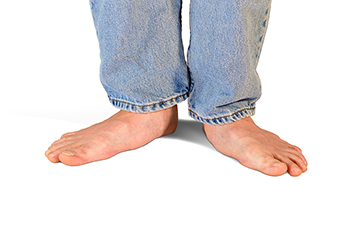Port Neches, TX (409) 727-1122
Types and Causes of Flat Feet
Tuesday, 02 May 2023 00:00
Having flat feet, medically known as pes planus, is the result of collapsed arches that absorb the shock of each step you take. The three main types of flat feet are flexible pes planus, posterior tibial dysfunction, and a tight Achilles tendon. Flexible flat feet is the most common type, indicated if the arch disappears when the foot bears weight. It is generally not painful, and with proper arch support can be contained. If the posterior Achilles tendon is torn, swollen, or has become injured, flat feet can result. This type can be caused by obesity, hypertension, or diabetes. When the tension between the calf muscles and the Achilles tendon is too tight, it may cause arch pain when you are active. Most babies are born with flat feet, and the arches develop as the baby grows, so it should not be a cause for alarm. In adults, however, it may be harmful to ignore flat feet, because the pain from overpronation can spread to the legs, knees, hips, and back. For help with any type of flat feet, it is suggested that you make an appointment with a podiatrist who can provide proper treatment options.
Flatfoot is a condition many people suffer from. If you have flat feet, contact Pete O’Donald, DPM from Texas. Our doctor will treat your foot and ankle needs.
What Are Flat Feet?
Flatfoot is a condition in which the arch of the foot is depressed and the sole of the foot is almost completely in contact with the ground. About 20-30% of the population generally has flat feet because their arches never formed during growth.
Conditions & Problems:
Having flat feet makes it difficult to run or walk because of the stress placed on the ankles.
Alignment – The general alignment of your legs can be disrupted, because the ankles move inward which can cause major discomfort.
Knees – If you have complications with your knees, flat feet can be a contributor to arthritis in that area.
Symptoms
- Pain around the heel or arch area
- Trouble standing on the tip toe
- Swelling around the inside of the ankle
- Flat look to one or both feet
- Having your shoes feel uneven when worn
Treatment
If you are experiencing pain and stress on the foot you may weaken the posterior tibial tendon, which runs around the inside of the ankle.
If you have any questions please feel free to contact our office located in Nederland, TX . We offer the newest diagnostic and treatment technologies for all your foot and ankle needs.





